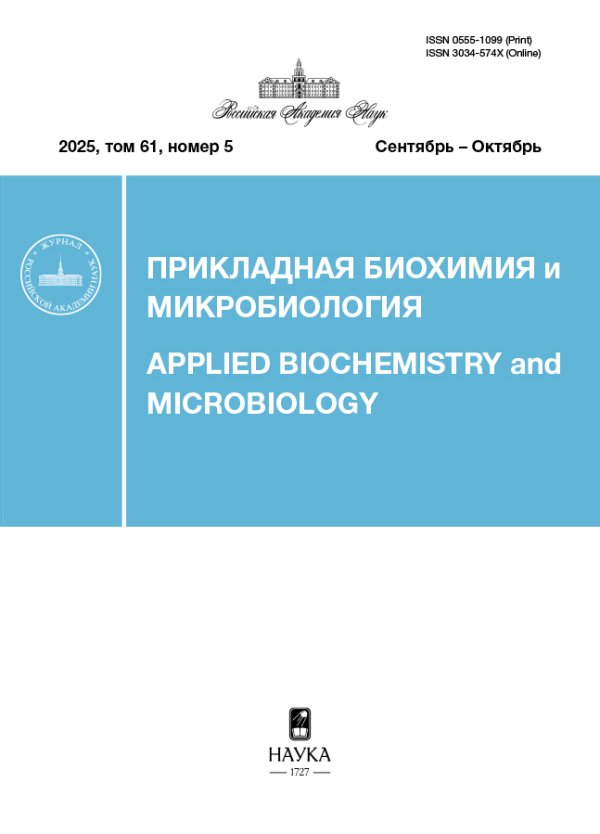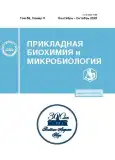Фаговые антитела для определения канамицина
- Авторы: Гулий О.И.1, Евстигнеева С.С.1, Староверов С.А.1,2, Фомин А.С.1, Караваева О.А.1
-
Учреждения:
- Институт биохимии и физиологии растений и микроорганизмов, ФИЦ “Саратовский научный центр РАН” (ИБФРМ РАН)
- Саратовский государственный университет генетики, биотехнологии и инженерии им. Н.И. Вавилова
- Выпуск: Том 59, № 5 (2023)
- Страницы: 512-519
- Раздел: Статьи
- URL: https://journals.rcsi.science/0555-1099/article/view/138818
- DOI: https://doi.org/10.31857/S0555109923050070
- EDN: https://elibrary.ru/NPHVMM
- ID: 138818
Цитировать
Полный текст
Аннотация
Получены рекомбинантные антитела, специфичные к канамицину, с использованием овечьей дисплейной библиотеки фрагментов scFv (Griffin.1) и показана возможность их применения для определения канамицина методом дот-иммуноанализа. Минимальная определяемая концентрация канамицина составляет 1 мкг/мл (различимое связывание метки, отличное от фонового уровня). Показано, что антиканамициновые фаговые антитела обладали специфичностью в отношении канамицина и не взаимодействовали с другими антибиотиками (неомицином, тетрациклином, ампициллином, гентамицином). Антиканамициновые фаговые антитела являются перспективной альтернативой моноклональным антителам для использования при определении канамицина.
Ключевые слова
Об авторах
О. И. Гулий
Институт биохимии и физиологии растений и микроорганизмов, ФИЦ“Саратовский научный центр РАН” (ИБФРМ РАН)
Автор, ответственный за переписку.
Email: guliy_olga@mail.ru
Россия, 410049, Саратов
С. С. Евстигнеева
Институт биохимии и физиологии растений и микроорганизмов, ФИЦ“Саратовский научный центр РАН” (ИБФРМ РАН)
Email: guliy_olga@mail.ru
Россия, 410049, Саратов
С. А. Староверов
Институт биохимии и физиологии растений и микроорганизмов, ФИЦ“Саратовский научный центр РАН” (ИБФРМ РАН); Саратовский государственный университет генетики, биотехнологии и инженерии
им. Н.И. Вавилова
Email: guliy_olga@mail.ru
Россия, 410049, Саратов; Россия, 410012, Саратов
А. С. Фомин
Институт биохимии и физиологии растений и микроорганизмов, ФИЦ“Саратовский научный центр РАН” (ИБФРМ РАН)
Email: guliy_olga@mail.ru
Россия, 410049, Саратов
О. А. Караваева
Институт биохимии и физиологии растений и микроорганизмов, ФИЦ“Саратовский научный центр РАН” (ИБФРМ РАН)
Email: guliy_olga@mail.ru
Россия, 410049, Саратов
Список литературы
- Willats W.G.T. // Plant Mol. Biol. 2002. V. 50. P. 837–854. https://doi.org/10.1023/A:1021215516430
- Wang L.-F., Yu M. // Curr. Drug Targets. 2004. V. 5. P. 1–15. https://doi.org/10.2174/1389450043490668
- Кузьмичева Г.А., Белявская В.А. // Биомедицинская химия. 2016. Т. 62. № 5. С. 481–495. Kuzmicheva G.A., Belyavskaya V.A. // Biochem. Moscow Suppl. Ser. В. 2017. V. 11. Р. 1–15. https://doi.org/10.18097/PBMC20166205481
- Smith G.P. // Science. 1985. V. 228. P. 1315–1317. https://doi.org/10.1126/science.4001944
- McCafferty J., Griffiths A.D., Winter G., Chiswell D.J. // Nature. 1990. V. 348. P. 552–554. https://doi.org/10.1038/348552a0
- Smith G.P., Petrenko V.A. // Chem. Rev. 1997. V. 97. P. 391–410. https://doi.org/10.1021/cr960065d
- Chassagne S., Laffly E., Drouet E., Hérodin F., Lefranc M.-P., Thullier P. // Mol. Immunol. 2004. V. 41. P. 539–546. https://doi.org/10.1016/j.molimm.2004.03.040
- Jacobsson K., Rosander A., Bjerketorp J., Frykberg L. // Biol. Proced. Online. 2003. V. 5. P. 123–135. https://doi.org/10.1251/bpo54
- Charlton K.A., Moyle S., Porter A.J.R., Harris W.J. // J. Immunol. 2000 V. 164. P. 6221–6229. https://doi.org/10.4049/jimmunol.164.12.6221
- Bashir S., Paeshuyse J. // Antibodies. 2020. V. 9. P. 21. https://doi.org/10.3390/antib9020021
- Тикунова Н.В., Морозова В.В. // Acta Nat. 2009. Т. 1. С. 22–31. doi.org/ Tikunova N.V., Morozova V.V. // Acta Nat. 2009. V. 1. P. 20–28. https://doi.org/10.32607/20758251-2009-1-3-20-28
- Zhao H., Nie D., Hu Y., Chen Z., Hou Z., Li M., Xue X. // Molecules. 2023. V. 28. P. 2621. https://doi.org/10.3390/molecules28062621
- Guliy O.I., Evstigneeva S.S., Dykman L.A. // Biosens Bioelectron. 2023. V. 222. P. 114909. https://doi.org/10.1016/j.bios.2022.114909
- Tang H., Gao Y., Han J. // Int J Mol Sci. 2023. V. 24 (4). P. 4176. https://doi.org/10.3390/ijms24044176
- Mahdavi S.Z.B., Oroojalian F., Eyvazi S., Hejazi M., Baradaran B., Pouladi N. et al. // Int J Biol Macromol. 2022. V. 208. P. 421–442. https://doi.org/10.1016/j.ijbiomac.2022.03.113
- Li L., Wu S., Si Y., Li H., Yin X., Peng D. // Compr Rev Food Sci Food Saf. 2022. V. 21. P. 4354–4377. https://doi.org/10.1111/1541-4337.13018
- Пристенский Д.В., Староверов С.А., Ермилов Д.Н., Щеголев С.Ю., Дыкман Л.А. // Биомедицинская химия. 2007. Т. 53. С. 57–64. Pristensky D.V., Staroverov S.A., Ermilov D.N., Shchyogolev S.Y., Dykman L.A. // Biochem. Moscow Suppl. Ser. В. 2007. V. 1. P. 249–253. https://doi.org/10.1134/S1990750807030146
- Staroverov S.A., Sidorkin V.A., Fomin A.S., Shchyogolev S.Y., Dykman L.A. // J. Vet. Sci. 2011. V. 12. P. 303–307. https://doi.org/10.4142/jvs.2011.12.4.303
- Staroverov S.A., Volkov A.A., Fomin A.S., Laskavuy V.N., Mezhennyy P.V., Kozlov S.V. et al. // J. Immunoassay Immunochem. 2015. V. 36. P. 100–110. https://doi.org/10.1080/15321819.2014.899257
- Staroverov S.A., Kozlov S.V., Fomin A.S., Gabalov K.P., Khanadeev V.A., Soldatov D.A. et al. // ADMET DMPK. 2021. V. 9. P. 255–266. https://doi.org/10.5599/admet.1023
- Гулий О.И., Алсовэйди А.К.М., Фомин А.С., Габалов К.П., Староверов С.А., Караваева О.А. // Прикл. биохимия и микробиология. 2022. Т. 58. № 5. С. 513–519. Guliy O.I., Alsowaidi A.K., Fomin A.S., Gabalov K.P., Staroverov S.S., Karavaeva O.A. // Appl. Biochem. Microbiol. 2022. V. 58. № 5. P. 646–651. https://doi.org/10.1134/S000368382205008810.1134/S0003683822050088https://doi.org/10.31857/S0555109922050087
- Durante-Mangoni E., Grammatikos A., Utili R., Falagas M.E. // Int. J. Antimicrob. Agents. 2009. V. 33. P. 201–205. https://doi.org/10.1016/j.ijantimicag.2008.09.001
- Jiang M., Karasawa T., Steyger P.S. // Front. Cell Neurosci. 2017. V. 11. P. 308. https://doi.org/10.3389/fncel.2017.00308
- Shavit M., Pokrovskaya V., Belakhov V., Baasov T. // Bioorg. Med. Chem. 2017. V. 25. P. 2917–2925. https://doi.org/10.1016/j.bmc.2017.02.068
- Tang M., Li F., Yang M., Zhang Y. // J. Environ. Sci. (China). 2020. V. 97. P. 11–18. https://doi.org/10.1016/j.jes.2020.04.032
- Jin Y., Jang J.W., Han C.H., Lee M.H. // J Vet Sci. 2006. V. 7(2). P. 111–117. https://doi.org/10.4142/jvs.2006.7.2.111
- Pietschmann J., Dittmann D., Spiegel H., Krause H.J., Schröper F. // Foods. 2020. V. 9. P. 1773. https://doi.org/10.3390/foods9121773
- Li C., Zhang Y., Eremin S.A., Yakup O., Yao G., Zhang X. // Food Chem. 2017. V. 227. P. 48–54. https://doi.org/10.1016/j.foodchem.2017.01.058
- DeCastro A.F., Place J.D., Lam C.T., Patel C. // Antimicrob Agents Chemother. 1986. V. 29. № 6. P. 961–964. https://doi.org/10.1128/AAC.29.6.961
- Wei Q., Zhao Y., Du B., Wu D., Li H., Yang M. // Food Chem. 2012. V. 134. № 3. P. 1601–1606. https://doi.org/10.1016/j.foodchem.2012.02.126
- Самсонова Ж.В., Щелокова О.С., Иванова Н.Л., Рубцова М.Ю., Егоров А.М. // Прикл. биохимия и микробиология. 2005. Т. 41. № 6. С. 668–675. Samsonova Z.V., Shchelokova O.S., Ivanova N.L., Rubtsova M.Y., Egorov A.M. // Appl. Biochem. Microbiol. 2005. V. 41. № 6. P. 589–595. https://doi.org/10.1007/s10438-005-0107-4
- Charlton K.A., Moyle S., Porter A.J., Harris W.J. // J. Immunol. 2000. V. 164. P. 6221–6229. https://doi.org/10.4049/jimmunol.164.12.6221
- Smith G.P., Scott J.K. // Methods Enzymol. 1993. V. 217. P. 228–257. https://doi.org/10.1016/0076-6879(93)17065-D
- Shah K., Maghsoudlou P. // Br. J. Hosp. Med. 2016. V. 77. P. 98–101.
- Frens G. // Nat. Phys. Sci. 1973. V. 241. P. 20–22. https://doi.org/10.1038/physci241020a0
- Guliy O.I., Zaitsev B.D., Burygin G.L., Karavaeva O.A., Fomin A.S., Staroverov S.A., Borodina I.A. // Ultrasound Med. Biol. 2020. V. 46. P. 1727–1737. https://doi.org/10.1016/j.ultrasmedbio.2020.03.014
- European Medicines Agency, European Surveillance of Veterinary Antimicrobial Consumption, 2021. “Sales of Veterinary Antimicrobial Agents in 31 European Countries in 2019 and 2020”. (EMA/58183/2021).
- Jin Y., Jang J.-W., Han C.-H., Lee M.-H. //J. Vet. Sci. 2006. V. 7(2). P. 111–117.
- Воронежцева О.В., Еремин С.А., Ермолаева Т.Н. // Вестник ВГУ, серия: Химия. Биология. Фармация. 2009. № 2. С. 11–17.
- Zhao Y., Wei Q., Xu C., Li H., Wu D., Cai Y., Mao K., Cui Z., Du B. // Sens. Actuators B Chem. 2011. V. 155. № 2. P. 618–625. https://doi.org/10.1016/j.snb.2011.01.019
- Shinko, E.I., Farafonova, O.V., Ermolaeva, T.N. // Zavodskaya Laboratroiya. Diagnostika Materialov. 2021. V. 87. № 12. P. 11–16. https://doi.org/10.26896/1028-6861-2021-87-12-12-17
- Shinko E.I., Farafonova O.V., Shanin I.A., Eremin S.A., Ermolaeva T.N. // Anal. Lett. 2022. V. 55. № 7. P. 1164–1177. https://doi.org/10.1080/00032719.2021.1991364
- Bizina E.V., Farafonova O.V., Zolotareva N.I., Grazhulene S.S., Ermolaeva T.N. // J. Anal. Chem. 2022. V. 77. № 4. P. 458–465. https://doi.org/10.1134/S1061934822040049
Дополнительные файлы















